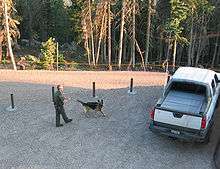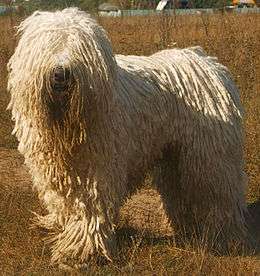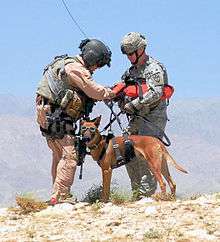Working dog
 This working dog is a border collie mix. |
A working dog is a canine working animal, i.e., a type of dog that is not merely a pet but learns and performs tasks to assist and/or entertain its human companions, or a breed of such origin. In Australia and New Zealand, a working dog is one which has been trained to work livestock, irrespective of its breeding.
Within this general description, however, there are several ways in which the phrase is used.
- To identify any dog that performs actions on a regular basis to assist people. In this context, a dog that helps a rancher manage cattle or that performs stunts for a trainer who receives pay for its acts is a working dog, as is a service dog or an assistance dog. This might be in comparison to a companion dog, whose purpose is primarily as a pet.
- To distinguish between dogs that are bred for appearance primarily to win conformation shows and working dogs that are bred primarily for their ability to perform a task. For example, a Border Collie that is a conformation champion is not necessarily a good sheepdog and a Border Collie that is a champion at sheepdog trials might not succeed in show rings for its nonstandard appearance. It is also possible that a specimen may excel in both appearance and performance. In many FCI countries it is impossible for some working breeds' dogs to become conformation champions without having passed adequate breed specific tests measuring their working abilities.
- For some breeds, there are separate registries for tracking the ancestry of working and show dogs. For example, in Australia, there are separate registries for working and show Australian Kelpies; the working registry encourages the breeding of any Kelpies with a strong instinct to herd, no matter their appearance or coat color; the show registry encourages breeding only among Kelpies whose ancestors were registered as show dogs and who have only solid-colored coats. Other breeds have just a working dog register, independent of the showing registers; such a breed is the Boerboel — the breeders of this dog consider entry into the AKC for example would damage the dog's genetic working base if it were ever to be bred for the showing.
- As a catch-all for dog breeds whose original purpose was to perform tasks that do not fit into a more specific category of work. For example, until 1983 herding dogs were part of the Working Group. The Herding Group was created when the Working Group became too large.[2] Today, the American Kennel Club uses Working Dogs to describe breeds who were originally bred for jobs other than herding or hunting. Such jobs might include pulling carts, guarding and so on. However, in practice these 'show' dogs under the AKC are not proper working dogs, and would indeed not be suitable for use as such. Many true working breeds are still very valuable as working dogs, and without them local economies would suffer. An example of such a breed is the Anatolian Shepherd, without which many sheep would be destroyed for example by wolves, feral domestic dogs, and in Namibia, the cheetah.
Jobs performed by dogs


Although most modern dogs are kept as pets, there are still a tremendous number of ways in which dogs can and do assist humans, and more uses are found for them every year. The following list provides an idea of the versatility of dogs:
- Turnspit dogs were used as a source of power, they turned a treadmill connected to a roasting spit. Similar arrangements were used for household duties such as churning butter.
- Dogs were used as draught animals to pull small carts for farms, peddlers, or travellers (milk, fish, rags & bones, meat, bread, and other products), to deliver mail, and to pull carts carrying people for transportation or entertainment. They were used in World War I to pull small field guns. Dogs in harness sometimes had guard dogs to protect them from stray dogs.[3] In 1839, a ban on draught dogs in London and a later ban on all draught dogs and a tax on other working dogs caused the deaths of over 150,000 dogs, who were replaced in their work by children and adults.[4]
- Service or assistance dogs help people with various disabilities in every day tasks. Some examples include mobility assistance dogs for the physically handicapped, guide dogs for the visually impaired, and hearing dogs for the hearing impaired.
- Therapy dogs visit people who are incapacitated or prevented in some way from having freedom of movement; these dogs provide cheer and entertainment for the elderly in retirement facilities, the ill and injured in hospitals, and so on. The very act of training dogs can also act as a therapy for human handlers, as in a prisoner rehabilitation project.
- Rescue dogs assist people who are in difficult situations, such as in the water after a boat disaster, lost in the wilderness, escaped from nursing homes, covered in snow avalanches, buried under collapsed buildings, etc.
- Herding dogs are still invaluable to sheep and cattle handlers (stockmen) around the world for mustering; different breeds are used for the different jobs involved in stock work and for guarding the flocks and herds. Modern herding dogs help to control cattle and wild geese in parks or goats used for weed control. A well trained dog can adapt to control any sort of domestic and many wild animals.
- Sled dogs, although today primarily used in sporting events, still can assist in transporting people and supplies in rugged, snowy terrain.
- Performing dogs such as Circus dogs and dog actors are trained to perform acts that are not intrinsically useful, but instead provide entertainment to their audience or enable human artistic performances.
- Hunting dogs assist hunters in finding, tracking, and retrieving game, or in routing vermin. For larger game animals such as wild boar or bears, dogs may be trained to either hold the prey at bay until the hunter arrives, or to directly attack and hold them.
- Guard dogs and watch dogs help to protect private or public property, either in living or used for patrols, as in the military and with security firms.
- Tracking dogs help find lost people and animals or track down possible criminals.
- Cadaver dog or Human Remains Detection Dogs use their scenting ability to discover bodies or human remains at the scenes of disasters, crimes, accidents, or suicides.
- Detection dogs of a wide variety help to detect termites and bedbugs in homes, illegal substances in luggage, bombs, chemicals, and many other substances.
- War Dogs or K9 Corps are used by armed forces in many of the same roles as civilian working dogs, but in a military context. In addition, specialized military tasks such as mine detection or wire laying have been assigned to dogs. Military Working Dog is the more formal, current term for dogs trained for use in military tasks.
- Police dogs, also sometimes called K9 Units, are usually trained to track or immobilize possible criminals while assisting officers in making arrests or investigating the scene of a crime. Some are even specially trained for anti-terrorist units, as in Austria.
- Dogs are sometimes used in programs to assist children in learning how to read. The Reading With Rover program in Washington pairs trained dogs with children who read aloud to the dog. This process builds confidence and reduces stress.[5]
- Canine cancer detection
Search and rescue dogs
Dogs are commonly used as search and rescue workers in cases of lost people and disasters. The St. Bernard was historically used in Europe in the case of avalanches and lost travelers. Search dogs are used in lost person searches each year saving human lives. Several breeds of dogs were used during World War I to locate wounded soldiers in the field. Several cities in Italy are experimenting with working dogs as rescue swimmers. In this situation, a strong and well-trained dog is equipped with flotation devices and dropped in the water near a floundering swimmer. The swimmer then grabs onto the dog, and the animal tows the swimmer to shore. The Newfoundland has long been used for water rescue, not only on shore, but from fishing boats as well.
Pets
The breeding of working dogs originated from selecting highly intelligent[6], hardy, alert mixed-breed dogs. Working dogs resulted when dogs with similar desirable characteristics, such as loyalty and good temperament, were bred. As a result, many working breeds are sought after as family pets. For search and rescue work, typical breeds seen in the field include Labrador Retrievers, Border Collies, German Shepherd Dogs and certain members of the hound group. These dogs should have a good prey drive, desire to please the handler, ability to work on and off lead, and be sociable in public settings.
Working dogs make excellent pets as long as potential owners realize that these dogs must be given 'work' to do. Dogs that are not to be used for their original purpose must be trained from a young age and are best suited to active persons and families. Obedience training, dog sports, informal or novelty shows, and trial work are all excellent channels for these breeds' energy. At the very least they must have daily walks or other exercise at an appropriate level for the breed, given toys, played with, and provided with human company.
Working dogs that are left alone or ignored become bored, vocal, and even neurotic; they may exhibit malaise, lethargy, destructive behavior or attempt to escape. Working dogs inappropriately chosen as pets are often surrendered to shelters for these reasons.
See also
- Anti-tank dog
- Service dog
- Working Group (dogs) for lists of dogs included in various kennel clubs' "Working Group" categorization, which is more narrowly focused than the general phrase "working dog".
- Limber tail syndrome
References
- ↑ Kovacs,Gibizer,Udvardine Lukacs: Komondor, Kuvasz, 1996, ISBN 963-7314-33-4
- ↑ Hartnagle-Taylor, Jeanne Joy; Taylor, Ty (2010). Stockdog Savvy. Alpine Publications. ISBN 978-1-57779-106-5.
- ↑ Vintage photos show uses of dogs pulling carts
- ↑ Dog carts and Lion Carts. 1839 Dog Cart Nuisance Act
- ↑ Grindeland, Sherry (2007-06-16). "Winning Smiles". The Seattle Times. Retrieved 2009-09-20.
- ↑ "Working Dogs". dogtime.com.

